A few years ago I learned there are thousands of ingredients used to make “fragrance”. Thousands! And companies don’t have to tell you which ones they use in their products because it’s considered proprietary. Instead of spraying yourself with perfume or body spray containing questionable ingredients, you can learn how to make perfume with essential oils. DIY perfume is easy to make and you get to create your own signature scent.
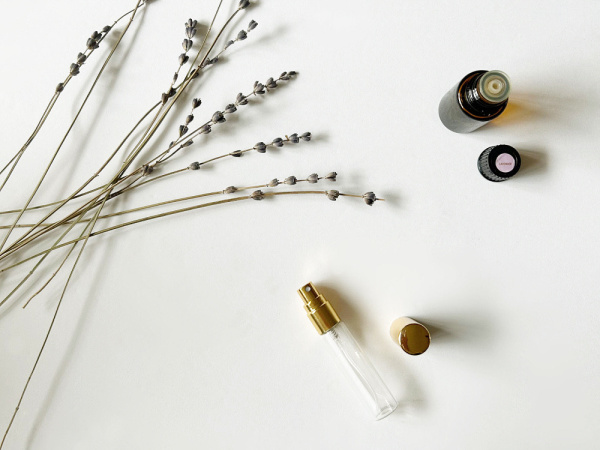
Did you know there is a list of every ingredient used in making “fragrance”? Care to guess how many items are on that list? 100?… 1,000?… Try 3,619 (as of January 2024). And here’s the crazy thing: companies do not have to disclose which of these 3,619 ingredients they use in their fragrance formulations because they are considered proprietary. If you look at a bottle of hand soap or lotion or cleaning spray, you’ll likely see the word “fragrance” on the ingredient list, which means each time you apply that product to your skin or spray it in the air you are exposing yourself to any number of the 3,619 ingredients on The International Fragrance Association’s transparency list. While I have figured out how to make many of my own cleaning products and personal care items, one thing I still needed to change out was my perfume and body spray. Had I realized just how easy it was to make your own perfume, I would have done it long ago.
Before we begin talking about how to make perfume, let’s discuss the art of combining different essential oils to create your own unique scent. It’s not quite as simple as taking a few of your favorite essential oils and adding drops at random; there’s an actual science to it. Different scents are assigned to one of three categories: top notes, middle notes, or base notes. In order for a perfume to “work”, there needs to be the right combination of each of these notes, so let’s break them down.
*Please note the following information can be used to make both perfume or cologne. Simply choose oils that work well for the person for whom you are making the scent.*
Top Notes, Middle Notes, & Bottom Notes for DIY Perfume
Affiliate links may be used. Please see our advertising disclosure for more information.
Top Notes in Homemade Perfume
Top notes are your “first impression”; the first scent we smell upon application. While there are always some exceptions, top notes tend to consist of citrus oils and herb-y oils. The thing about top notes is they tend to evaporate rather quickly; typically within 30 minutes of application. Top notes should comprise about 30% of the perfume.
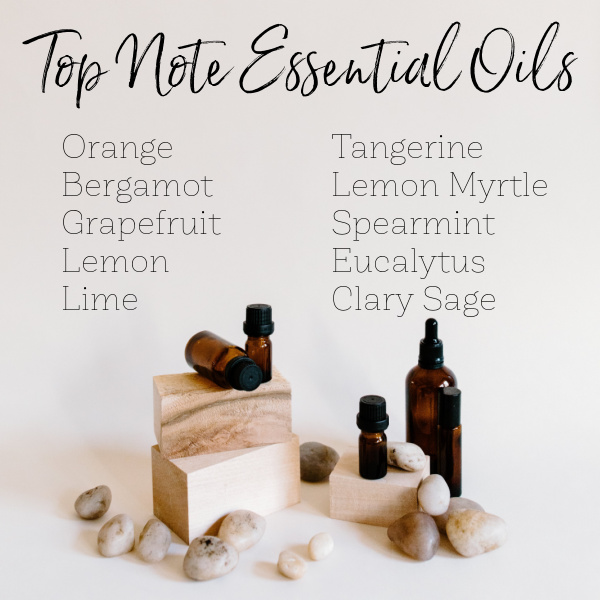
Orange | Bergamot | Grapefruit | Lemon | Lime | Tangerine | Lemon Myrtle | Spearmint | Eucalyptus | Clary Sage
*I link to essential oil brands I believe provide high quality oils and are transparent with their testing (in other words, the company publicly provides GC/MS results). I also try to link to the essential oil that will give you the “biggest bang for your buck” (often times buying a 30ml bottle of oil means greater savings per ml than purchasing a 10ml bottle). I provide more information on where to buy essential oils so you can choose a brand you feel is right for you.
Middle Notes in DIY Perfume
Middle notes are the heart of the perfume, making their entrance just as the top notes are wearing off. Middle notes often mask any unpleasant odor that comes from the base notes, as base notes tend to smell better with time. Middle notes are often made up of floral and spice oils. Middle notes should make up about 50% of the perfume.
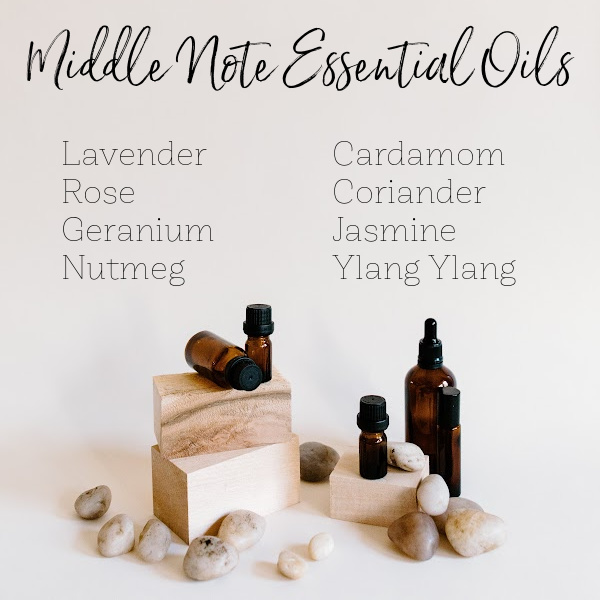
Lavender | Rose | Geranium | Nutmeg | Cardamom | Coriander | Jasmine |Ylang Ylang
Base Notes in for Homemade Perfume
If top notes are your first impression and middle notes are the heart, base notes are the depth. (Kinda sounds like we’re walking through the stages of a relationship, doesn’t it?) Base notes are often made up of earthy and woodsy essential oils, making up the last 20% of the perfume.
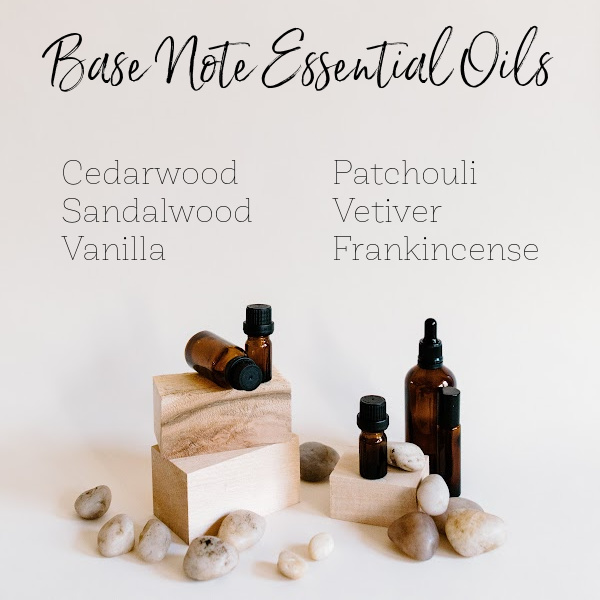
Cedarwood | Sandalwood | Vanilla | Patchouli | Vetiver | Frankincense
Essential Oils to Avoid Using in Perfume
One last word of caution before we begin. Certain essential oils are considered “hot oils”. Because of their chemical make-up, they can cause a burning sensation, irritation, and/or redness. I would not recommend the use of these particular essential oils in homemade perfume.
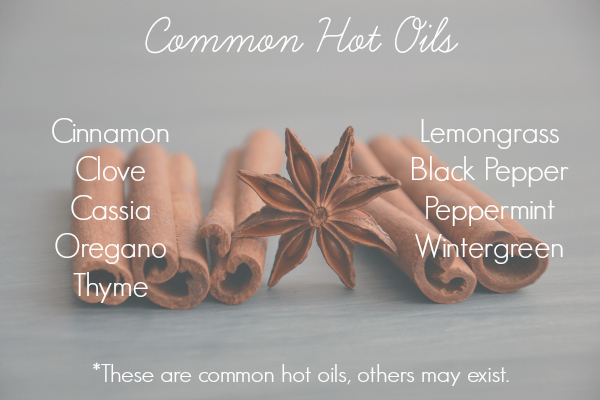
If you experience any irritation after application, apply a carrier oil like olive oil or fractionated coconut oil to the area, and continue to do so until the irritation subsides.
Now that we know the formulation and which oils we want to try (as well as those we should avoid), let’s get started.
What You Need to Make DIY Perfume
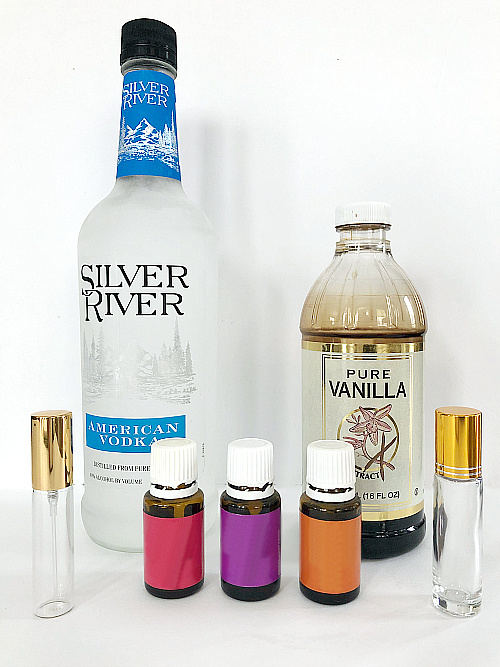
Affiliate links may be used. Please see our advertising disclosure for more information.
Ingredients Needed for Homemade Perfume
- Vodka or Odorless Carrier Oil- This recipes uses Vodka, however, you can use an odorless carrier oil (such as fractionated coconut oil) in its place; just note that you will need to use a roller ball (vs a spray bottle) and the mixture will be oily on your skin when applied.
- Top Note Essential Oil(s)- See list above for some suggestions
- Middle Note Essential Oil(s)- See list above for some suggestions
- Base Note Essential Oil(s)- See list above for some suggestions
Not sure where to buy essential oils? Check out this post.
Supplies Needed When Making DIY Perfume
- Small Funnel or Small Dropper
- Glass Roller Ball Bottle or Glass Spray Bottle– I would recommend going with 10ml roller balls or spray bottles to start as this allows you to experiment with different scent combinations. Once you have your signature scent, you can buy a larger perfume bottle and make a bigger batch. ***Please see notes re: larger spray bottles.
How to Make Perfume At Home with Essential Oils
Start by picking out one or two favorite essential oils from each category: top note, middle note, and base note. If you can’t decide which oils might smell nice together, try putting the combination in a diffuser using 3 drops of the top note, 5 drops of the middle note, and 2 drops of the base note. Diffusing will help you experience the full essence of the oils when combined.
Once you have your selection, place 6 drops of your “top note” choice(s) into your bottle. If you are selecting more than one oil for your top note, simply divide up the drops so the total is equal to six.
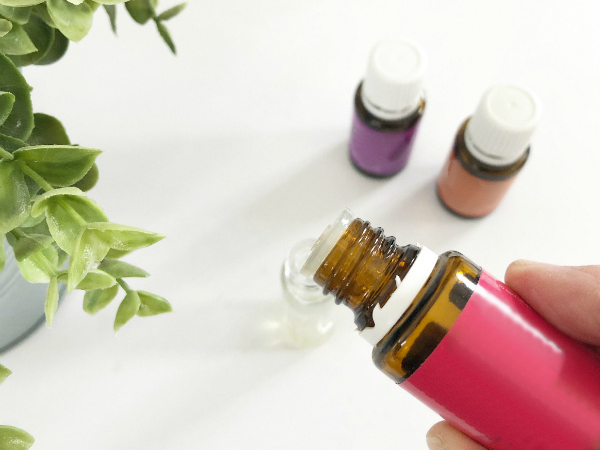
Next, add in a total of 10 drops of your middle note choice(s).
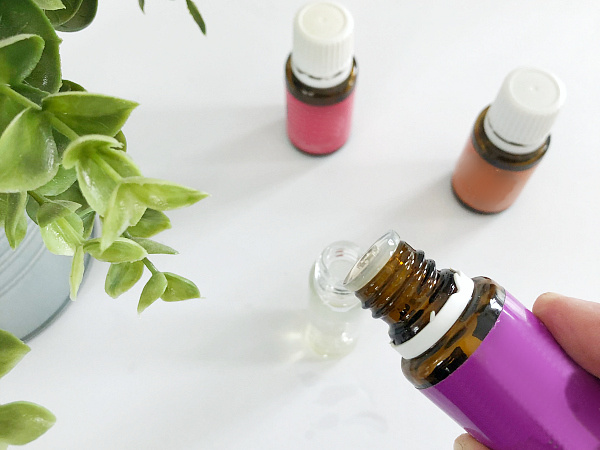
And lastly, add in a total of 4 drops of your base note choice(s).
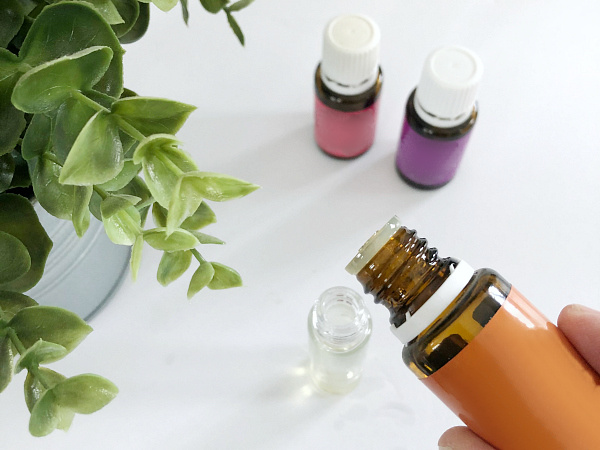
Once all your oils have been added give the bottle a little swirl to combine the essential oils together. Next, use a small funnel (or dropper) and fill the remainder of the bottle with vodka (or a carrier oil if you choose to go that route). Remember to be careful and pour slowly 🙂
***For larger spray bottles: When using containers larger than 10ml, add your oils and then add 1 oz. of vodka. Give this a little stir and fill the remainder of your container with distilled water.
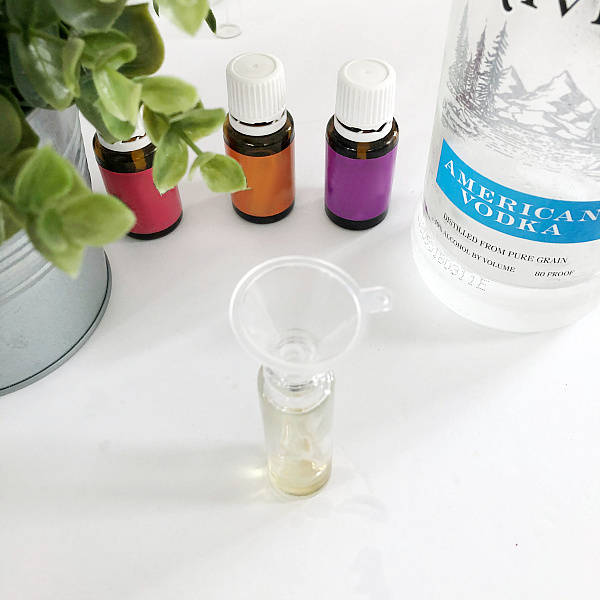
Pop the roller ball onto your bottle or attach the spray mechanism and give the mixture a good shake.
For best results allow the perfume to sit for at least 24 hours as this allows all the scents to meld together. I have read in some places to allow it to sit for up to a month! I’m not sure I’m that patient 🙂
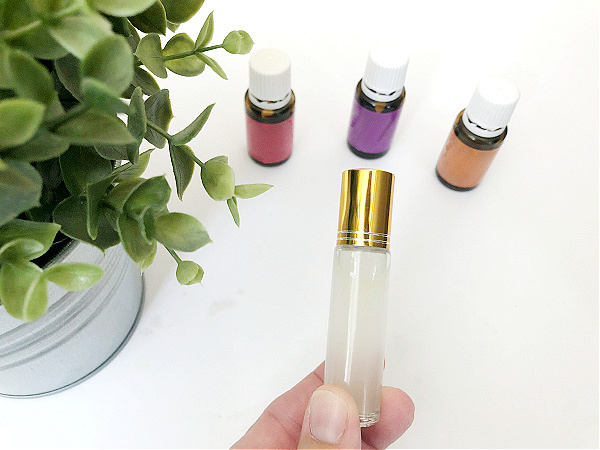
Of course you can name your signature scent and apply a label to the bottle if desired. When ready to use, give it a little shake and apply as you would any perfume.
Prior to trying any skin care product, it is strongly recommended that you test the product on a small patch of skin to make sure there is no reaction. Please see our disclaimer statement for more details.
Common Questions About DIY Perfume
Should I Use Alcohol or Oil for Homemade Perfume?
Alcohol and oil both have their pros and cons when it comes to making perfume. Alcohol-based perfume has a longer shelf-life, and because it evaporates faster than oil, the scent is stronger to those around you. The downfall for alcohol is that is can be drying to the skin. An oil-based perfume, on the other hand, can be moisturizing to the skin, which is a plus. Oil-based perfume will also stay on the skin longer, but the scent won’t come off as strong as an alcohol-based perfume.
Can I Use Rubbing Alcohol When Making DIY Perfume?
No! Everyone knows the smell of rubbing alcohol, right? Smells like a doctor’s office. Rubbing alcohol has such a strong scent, it will overpower the essential oils. The reason I chose vodka for this DIY perfume recipe is because vodka has no scent, therefore, the natural scent of the essential oils shines through.
Can I Use Vanilla Extract When Making Perfume At Home?
Technically… yes, but here are a few things to consider if you’d like to use vanilla extract in your DIY perfume. First, pure vanilla extract contains a large percent of alcohol, which can be drying to the skin. Second, for those sensitive to vanillin, you could experience skin irritation or an allergic reaction. Spoon University interviewed Dr. Dinopol, a board-certified dermatologist about the use of vanilla extract as a perfume, and she is quoted to say, “if you don’t have allergies to Balsam of Peru or vanillin, and you don’t have sensitive skin, using vanilla extract as a perfume might work for you.” Another thing to consider is that pure vanilla extract can stain your clothing. With those words of caution, if you choose to use pure vanilla extract in your base, simply pour a very small amount into a small dish and use a dropper to add the number of drops desired to your perfume.
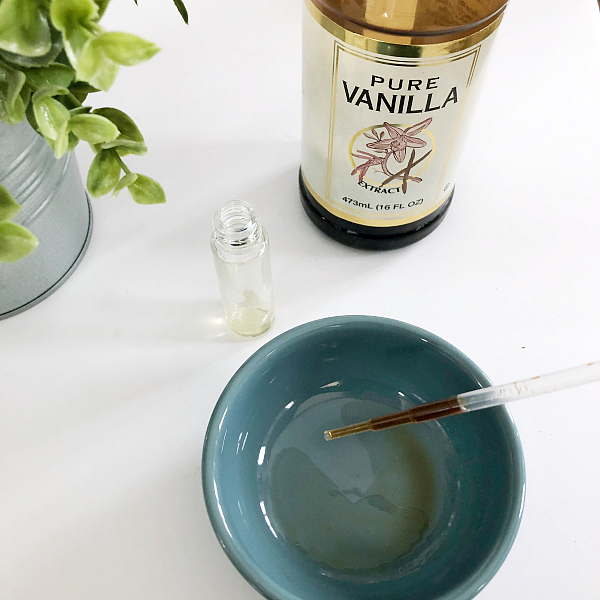
What is the Shelf Life of Homemade Perfume?
This is a great question with not a whole lot of solid answers. Store-bought perfumes are said to have a shelf-life of 3-5 years. Because store-bought perfumes are alcohol-based, we can assume our homemade, alcohol-based, perfume should have a similar shelf-life. With that being said, perfume will last longer if stored in a cool, dark environment. If you ever notice your perfume starting to smell “off”, it’s time to toss it and make a new batch. Oil based perfume doesn’t last as long as alcohol based, but still should last about a year. Same rules apply: if it smells a little funky, toss it and make a new batch.
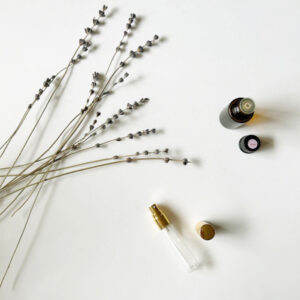
DIY Perfume
Ingredients
- 6 Drops Top Note Essential Oil(s) See post for examples of top notes
- 10 Drops Middle Note Essential Oil(s) See post for examples of middle notes
- 4 Drops Base Note Essential Oil(s) See post for examples of bottom notes
- Vodka or Carrier Oil
Supplies
- Small Funnel or Small Dropper
- Glass Spray Bottle (10ml) or Glass Roller Ball (10 ml)
Instructions
- Start by adding 6 drops of your top note essential oil(s) to your bottle or roller ball. Then add 10 drops of your middle note essential oil(s), followed by 4 drops of your base essential oil(s).
- Swirl the essential oils around for a couple seconds to allow them to mix together
- Use a funnel (or dropper) to fill your bottle/roller ball the rest of the way with either vodka or carrier oil (if using a carrier oil, you will need to use a roller ball as oil will not spray out of a spray bottle).
- Replace the top of the sprayer or roller ball and give it a good swirl to combine
- Allow the perfume to sit for a minimum or 24 hours, or up to a month, to allow the scents to meld together.
- To use, apply one to two sprays to wrist and/or neck
Love it? Pin it!
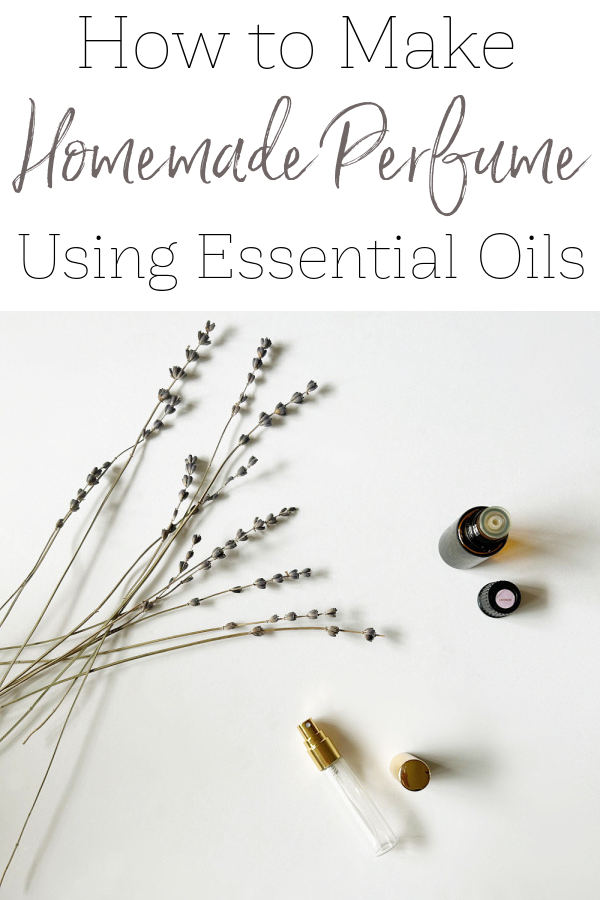
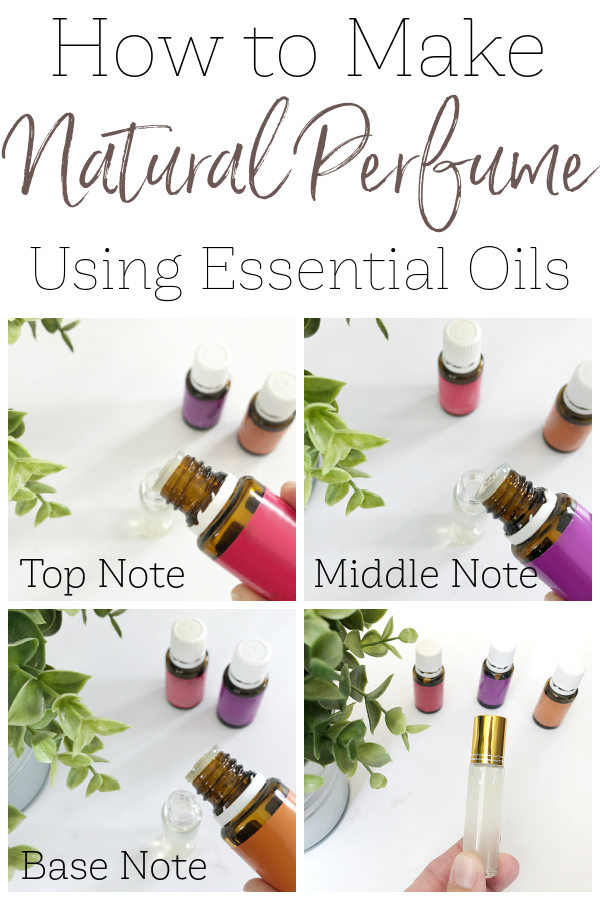

Hello! Is it possible to just use 20 drops of lavender essential oil (or other single essential oil) when making the perfume? Or do you always recommend mixing 3 essential oils as outlined in the instructions? Thank you!
If you only want to use one essential oil, you can certainly do that. It just may lack a little “depth” that a combination of essential oils provides. Totally up to you though 🙂
Hey! What a great post! I was wondering – do you think using a carrier oil would make the scent last longer than alcohol ?
Thank you so much – I do enjoy your posts.
Using oil instead of alcohol will definitely make the perfume scent last longer, however, it won’t smell as strong unless you a closer to the perfume. Alcohol allows the scent to travel further as it evaporates.